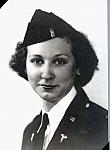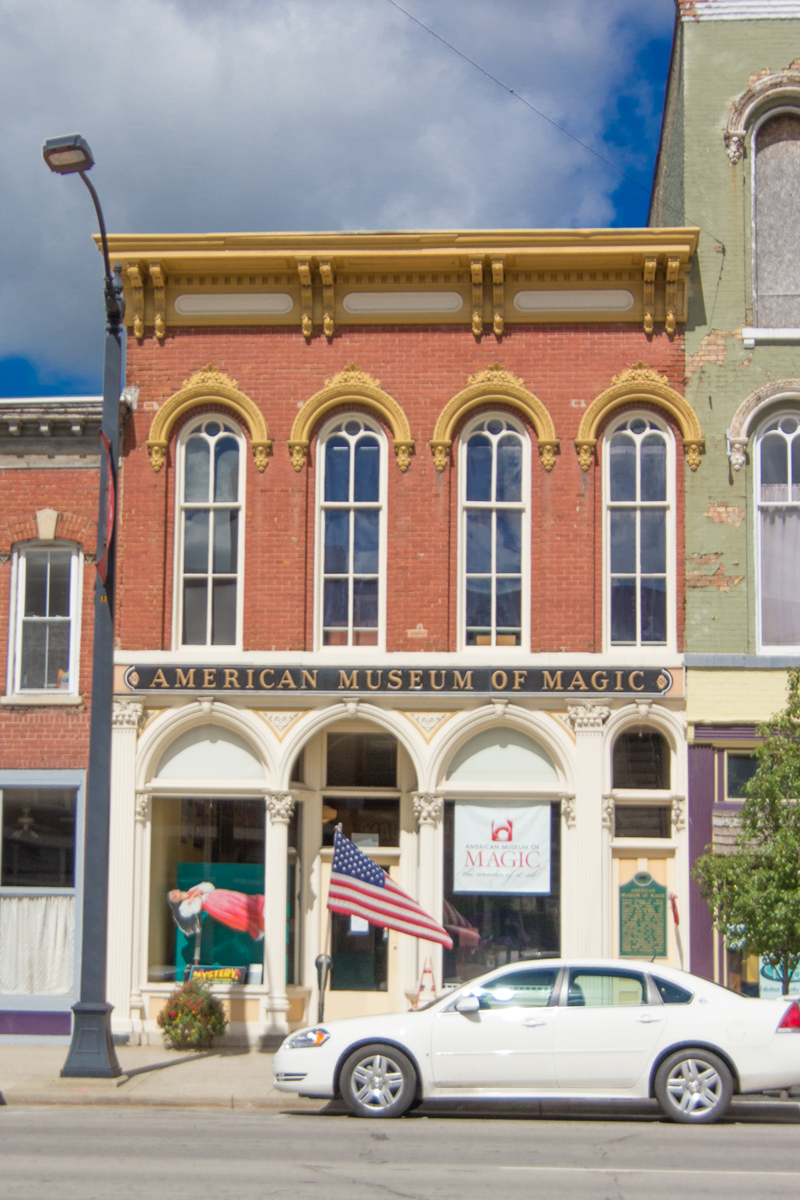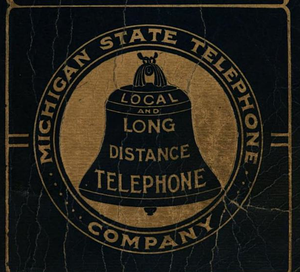On April 1, 1875, a hard winter left a huge ice floe that collapsed five bridges in Lansing.
The trouble started at Mineral Wells Bridge, which was newly constructed at the time. The ice floe took that bridge with it, and went on to collapse four more bridges. The Michigan Avenue Bridge was spared because it was constructed without a center support.
Source: Michigan Every Day
The state’s first yellow-pages directory was issued by the Michigan State Telephone Company on this date in 1906.
More odds and ends about old telephone books
Sources :
Historical Society of Michigan
The phone book : the curious history of the book that everyone uses but no one reads / Ammon Shea. New York : Perigee Book, 2010. Available through interlibrary loan via MelCat.
One hundred years ago this month, the Michigan Legislature approved Public Act 34, authorizing the sterilization of any “mentally defective person” held in a state institution. Michigan had been the very first state to consider a compulsory sterilization bill.
In 1897, W. R. Edgar, a physician and state representative, proposed “An Act for the Prevention of Idiocy” that would have required the “asexualization” of mental health patients, prisoners with three felony convictions, and anyone who had been convicted of rape or child molestation. Under his proposal, men would have been castrated and women would have received radical hysterectomies in order to “cease to be able to reproduce their kind.” In a very close vote, the bill failed to pass.
In 1907, Indiana became the first state to enact compulsory sterilization. Six years later on April 1, 1913, Michigan enacted a sterilization law that targeted patients in the state’s mental health hospitals. By 1932, two-thirds of U.S. states had adopted similar laws, which were part of the broader American eugenics movement.
Michigan’s compulsory sterilization law was finally repealed in 1974.
For the full article, see Mark A. Largent, “Michigan must apologize for coerced sterilizations of the past”, Detroit News, April 17, 2013.
Professor Robert Rydell of Montana State University talked about the history of eugenics in early 20th century America. Eugenics is a science that advocates improving the hereditary qualities of a race through controlled mating. Professor Rydell talked about some of the eugenics studies and experiments that took in the United States, as well as eugenics-based forced sterilization laws passed by several states that targeted the so-called “feebleminded.” Eugenics in Early 20th Century America via C-SPAN.

Twenty-two year old Joy Lillie from Coopersville, Michigan, began her service with the U.S. Army Nurse Corp during WWII on April 1, 1943. She was originally assigned to a hospital ship serving wounded soldiers from Sicily and Italy. Later on she was reassigned to a field hospital unit and found herself in full combat gear (including helmet) climbing the bluffs of Normandy searching for wounded soldiers six days after the landing at Omaha Beach, June 6, 1944.
Lillie and 17 other women in her platoon were on the front lines of every major campaign in Europe: Normandy, Northern France, Battle of the Bulge, Rhineland, and Central Europe. Her medical team advanced as the battle moved forward. They were never farther than thirty miles from the front line. Joy recalled the time they got too close to the front and the whole platoon spent twelve hours in a ditch waiting for the fighting to stop. The 51st Field Hospital’s tents and cots could be relocated to treat the wounded. “We got used to the sound of the airplanes, the bombs, the fighting” she says. “I was brave in those days. The idea was to get as close to the front lines as possible, do the repair work, and send them to the evacuation hospitals as soon as possible.”
They worked twelve-hour shifts, and had 50 men in their care. The platoon’s facilities were primitive, as expected, and everyone bathed using their metal helmets. Joy wrote home that she would go 30 days without a bath. The medical team had to make do with what was available. As the winter months settled in, it became so cold that the blood and plasma would not flow. Engineers brought in pot-bellied stoves to warm it enough to start the flow. Twice during their time there, they were able to setup in real buildings; one was an abandoned schoolhouse and another a blown out public building. But it was a welcome change to have a real roof over their heads.
On April 12, 1945, their platoon was the first medical unit on the scene of the gruesome German death camp, Nordhausen, a death camp created by Nazis for prisoners too weak or ill to work in the tunnels of Dora-Mittelbau work camp making German ockets, as it was being liberated. They found dead bodies stacked on top of each other like “cordwood”.
The nurses patched up the wounds of the living and helped where they could. Dysentery was a major problem as they attempted to feed the liberated prisoners. This particular prisoner of war camp did not have gas chambers, but instead held political prisoners. They weren’t fed enough to live on; if they could no longer work, they were left to starve.
Joy served overseas for two years, eight months stateside, and earned the rank of first lieutenant. The bronze star was given to her for working 72 hours straight during the Normandy invasion. In 2002, Pete Hoekstra delivered the remaining medals commemorating her service to her country. She was awarded the following medals: Bronze Star, American Campaign, European-African-Middle Eastern Campaign, WWII Victory, Normandy Medal, and Honorable Service Lapel Button WWII.
Following the war she and her husband Russ who was also in the military were re-united in January 1946, and they had each other to help work out some of the scars left from the hardship of battle. They established a home on a small farm near Grand Rapids, and raised a family of ten, and Joy stayed home caring for the family for seventeen years. Then, she took a refresher course in nursing and went back to caregiving for 20 more years. She died at the age of 91 in the fall of 2011.
Sources:
Cindy Laug, “Joy Lillie: Nurse Goes to War”, Grand Rapids Historical Commission Blog, March 9th, 2012
Susan Harrison Wolffis, “The Nurse Who Went to War”, Muskegon Chronicle, March 31, 2002, front page.
For further reading,
Fessler, Diane Burke. No Time for Fear: Voices of American Military Nurses in WWII. Michigan State Univ. Press. 1996. Also available online.
Monahan, Evelyn. And if I Perish: Frontline U.S. Army Nurses in WWII. Alfred A. Knopf, 2003.
Norman, Elizabeth M. We Band of Angels: The Untold Story of American Nurses Trapped on Bataan. Random House, 1999.
On April 1, 1951, the cornerstone was laid for the new International Institute at Kirby Avenue and John R. The International Institute of Metropolitan Detroit (IIMD) was founded in Detroit in 1919 by a group of YWCA volunteers, who sought to help legal immigrants learn English, appreciate freedom and democracy, become U.S. citizens, be assimilated into their new communities, and learn to understand each other’s cultures. The International Institute is today a 501(c)(3) non-profit organization, located in Detroit’s vibrant University-Cultural Center/Midtown District, that offers a variety of legal and educational services and programs to assist immigrants become productive U.S. citizens, while preserving the language, culture, food, music, dance, costumes, and heritage of their native countries from around the world. Our building houses the award-winning “International Cafe” restaurant; display cases housing the Ethel Averbach International Doll Collection, the world’s largest collection of dolls (over 2,500) dressed in international native costumes; the Wilkinson Immigrant Model Ship Collection; the “Hall of Nations” auditorium with flags from around the world; as well as classrooms and offices to carry out our many programs. The International Institute has been accredited by the U.S. Department of Justice, Board of Immigration Appeals, since 1958. It has also been accredited by the Council on Accreditation of Services for Families and Children, Inc., since 1990.
Source : Detroit Historical Society Facebook page
On April 1, 1963, Michigan voters approved a new constitution – the first Constitution in the United States to create a Civil Rights Commission charged with securing equal protection without discrimination. Today, we celebrate that progressive spirit and 50 years of civil rights protections in Michigan.
Today, the Michigan Department of Civil Rights maintains a website where Michiganders can request help regarding a number of issues.
Recent initiatives include:
Filing a complaint on February 8, 2013 with the U.S. Department of Education, Office of Civil Rights (OCR), asking the federal agency to issue an order prohibiting the continued use American Indian mascots, names, nicknames, slogans, chants and/or imagery (hereafter referred to as “imagery”). MDCR’s complaint asserts that new research clearly establishes that use of American Indian imagery negatively impacts student learning, creating an unequal learning environment in violation of Article VI of the Civil Rights Act of 1964.
Releasing a draft “Report on LGBT Inclusion under Michigan Law with Recommendations for Action” (January 28, 2013) which finds allowing discrimination against LGBT in Michigan leads to a negative economic impact on th economy.
Following the passage of the Matt’s Safe Schools Law in late 2011, officials from the Michigan Department of Education (MDE) and the Michigan Department of Civil Rights (MDCR) came together to develop a joint initiative designed to ensure school districts have the support they need to implement effective anti-bullying programs. The initiative is aimed at reducing destructive peer interactions, thus improving behavior and attitudes in schools and communities….In December, Michigan’s public school districts were invited to apply for consultative support in developing and implementing anti-bullying programming. Nine districts expressed interest in being part of the pilot program. Of the applicants, three districts were selected to participate: Detroit Public Schools, Vandercook Lake, and Allendale Public Schools.
Other reports released in recent years include:
A Report on Conditions of Migrant and Seasonal Workers in Michigan, March 2010.
“One Michigan” at the Crossroads: An Assessment of the Impact of Proposal 06-02 By the Michigan Civil Rights Commission, March 7, 2007
On April 1, 1963, Michigan voters narrowly approved the state’s new constitution, the governing document the state is still run under. After a recount, the “yes” votes won with 50.2 percent of the vote, or 810,860-803,436. It went into effect Jan. 1, 1964.
Originally, the document had 19,203 words. It now has 35,858 words.
Source: House Fiscal Agency, the Citizens Research Council.
How badly will the Larry Nassar wholesale sexual abuse scandal impact Michigan State University’s reputation? Perhaps not that much in the long run according to a recent article by Politico.
Eric Scigliano points out that” little over 50 years ago, another national scandal overtook Michigan State University, an academic and political cause célèbre that seemed to leave the school indelibly associated with—even, in some quarters, blamed for—nothing less than America’s war in Vietnam. Today the fateful exercise in nation-building and government-and-gown cooperation known as the Michigan State University Advisory Group rates but a footnote in popular histories of the war, if that. Ken Burns’ and Lynn Novick’s recent 18-hour documentary series The Vietnam War does not mention it at all.
MSU’s role in supporting and propping up Vietnam was revealed in the April 1966 issue of Ramparts. The main article recounted … how an overambitious university had sold its soul, become a shameless CIA front, and helped launch a ruthless dictatorship and wasteful war by miring itself in a self-serving “Vietnam Adventure,” complete with the servants, spacious villas, free-flowing booze and other perks of the neocolonial elite.
This indictment has been taken up lately by Jeremy Kuzmarov, a history professor at the University of Tulsa, who denounced MSU’s role in “the making of a police state in South Vietnam” in his 2012 book Modernizing Repression and in a critique of the Burns/Novick documentary for HuffPost. It’s an appealing narrative, especially in light of the blunders and tragedies that ensued in Vietnam.”
For the entire story see Eric Scigliano, “The University That Launched a CIA Front Operation in Vietnam“, Politico, March 25,2018. How the friendship between a Vietnamese politician and an American academic led Michigan State University into a vast experiment in nation-building and pulled America deeper into war.
“In retrospect, backlash against MSU’s Vietnam involvement made it an early hotbed of organizing by the Students for a Democratic Society (which was founded nearby at the University of Michigan), and the school became home to what may have been the nation’s first campus-based underground newspaper. Many of the MSU faculty who provided help and advice faced considerable flak including President John Hannah, who abruptly resigned from MSU in 1969 and became director of the U.S. Agency for International Development.
Since then, Michigan State has undergone a collective process of self-examination over its role in Vietnam. In 1998, its university press released Ernst’s Forging a Fateful Alliance, the most complete history published of the MSU Group. Formerly assailed for packing its Vietnam records away uncatalogued, the university has since digitized more than 80,000 documents and posted them online. Any academic or intellectual tempted to enlist in future U.S. efforts to remake other nations would do well to consult both.”
With their usual shouts of “Free the weed!” beneath hand-painted banners and leafy green flags, marijuana users and their pals by the thousands are set to gather Saturday in Ann Arbor for the 47th annual Hash Bash — a quirky combination of stoner silliness, political activism and open marijuana smoking that’s held smack in the middle of a college campus.
The University of Michigan takes pains to say it does not endorse the event — but can’t prevent it. The spring rite of speeches, live music and cannabis consumption lands always on the first Saturday of April at the U-M Diag, a plaza of diagonal sidewalks specially reserved for controversial free speech.
At each Hash Bash, campus police traditionally remind the crowd that smoking marijuana is illegal, then ring the group, although they do so at a distance, smiling and chatting with onlookers, and typically arrest only those who flaunt the sale or use of pot.
Some credit John Sinclair, the gray-haired poet and lifelong political activist, for starting it all. Sinclair had his 10-year prison sentence for marijuana possession overturned in 1971 after the Michigan Supreme Court ruled that Michigan’s marijuana laws were unconstitutional. That news triggered the spontaneous occurrence of Hash Bash No. 1 on April 1, 1972, igniting rebellious fervor within a short and some said glorious window when Michigan had no law against marijuana on the books, according to previous Free Press reports.
For the full article, see Bill Laitner, “Hash Bash coming to the University of Michigan’s Diag on Saturday“, Detroit Free Press, March 31, 2017
Bill Laitner, “Thousands gather for annual Hash Bash seeking legalization“, Detroit Free Press, April 2, 2017.
Founded on April 1, 1978, the American Museum of Magic in Marshall is the largest magic museum in the United States open to the public.
Attractions spawned from the obsession of one man (or woman) often do not survive their creators. The Wheels Museum, the Cypress Knee Museum, the Tower of Pallets — all disappeared soon after their founders exited stage left, lingering only in memory … primarily the memory of people like us.
That’s why it’s refreshing to see the American Museum of Magic perform its escape trick every day it manages to open to the public.

The American Museum of Magic was the progeny of Bob Lund, who began collecting magicians’ artifacts in the mid-1930s and didn’t stop until he died in 1995. Lund took pride in acquiring not only the props and posters of well-known magicians — Blackstone, Dunninger, Houdini — but of thousands of obscure, small-town conjurers as well. He went without a car and ate peanut butter sandwiches for years just so that he could buy more stuff. Had he lived, eBay would have killed him.
In mid-1970s Bob’s wife Elaine told him, “Either stop collecting or move to a bigger place.” Bob naturally chose Option 2. He and Elaine moved to Marshall, bought and renovated an ancient, three-story building in the historic district — and the town’s old library as well — and turned them into the world’s largest privately owned and publicly displayed collection of magic paraphernalia.
Elaine kept the place open after Bob died, but by then she was old, too, and the collection was getting disorganized. Happily, people are obsessed with magic and funds were raised. In 2005 a board of directors stepped in and began restoring the American Museum of Magic to its former glory.
The Lunds, despite their love of forgotten magicians, were sharp enough to put their superstar artifacts up front, to draw in people like us. Thus the first thing that you’ll see when you enter is the custom-made milk can into which Harry Houdini would crawl — handcuffed — and then be thrown into the Detroit River. Next to the door is the box for Harry Blackstone’s “Jam Illusion,” in which two beautiful ladies were apparently crushed, but emerged unharmed. It now holds a TV for showing videos.
The Museum is just up the road from Colon, Michigan, “The Magic Capital of the World,” home of Abbott’s Magic Company, the grave of Harry Blackstone Sr., and the annual Colon Magic Festival. The American Museum of Magic is really a destination for magic geeks who already know their stuff, where the faithful can come to gawk at their heroes — just as we do — and to ponder the spoor left by obscure progenitors of prestidigitation such as Ali Bongo, Mystic Craig, and Glenroy the Midget.
Sources:
American Museum of Magic wikipedia entry
American Museum of Magic, RoadsideAmerica.com.

